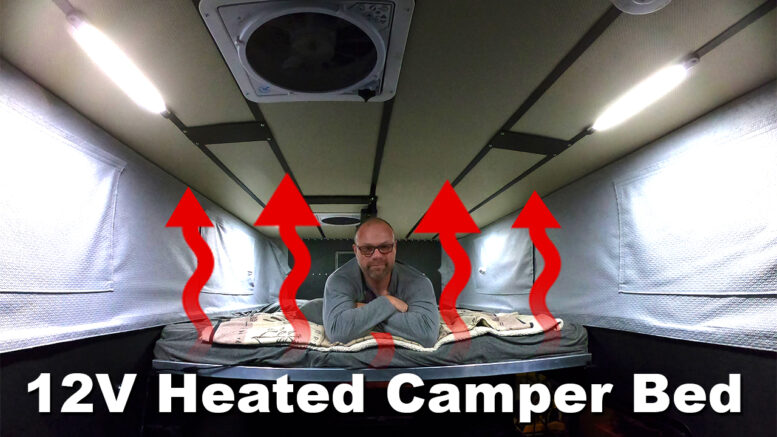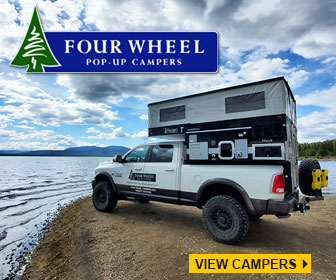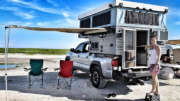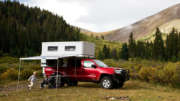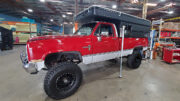With nights getting significantly colder here at home base, the only thing I had accomplished thus far in the build-out for the interior of the Project M camper on #BigRedK10 is installing modular camper flooring. Coming up with a simple, cost-effective heat camper bed solution for sleeping in the camper became a top priority.
Bed cushions are an option from Four Wheel Campers, which I selected. They are made with a very durable upholstery and are a good base to work from for the bed. I went ahead and purchased a 1.5 inch memory foam topper to add cushion, and some air circulation between me and the vinyl upholstered cushions. This added comfort and a bit of insulation to the sleeping surface which helped, but an external source of heat was still needed.
With an 8 foot bed, the camper interior is quite large in volume. From the back interior wall over the tailgate to the front wall, it’s actually 12 ft, and 6 ft wide. That’s a lot of space to heat while isolated in bed, burning up lots of valuable fuel with some sort of furnace. I tried to think out-of-the-box from the traditional ways people keep warm throughout the night in their campers, especially because I’m on a thin budget.
Since I try to think of my camper more like a homestead, efficiency is always a priority. The solution I came up with was localizing heat to the bed. I did some research and found a 12V heated travel blanket that pulls about 3 amps on low setting. The blanket heats up to about 85F, deals with problematic condensation in bed at night and provides a source of ambient/radiant heat in your camper interior. The best part is it’s around $20 and available on Amazon.
Low 12V Power Consumption for Radiant Camper Heat
Once the heated travel blanket arrived, I tried it out that evening, plugging it directly into Project M power station, via the 12V socket port. The heated blanket has a switch for low/high settings and a built-in 5 amp fuse.
The power station houses a 78amp AGM battery, so roughly half of that amp/hour storage is usable. This was the primary pass/fail test. Would the power draw from this heated blanket be feasible for a portable power station? On low setting, the blanket draws 3.25 amps (4.25 on high). At 3.25 amps, it was feasible and I was very excited. I kept an eye on the power draw meter, and started noticing the blanket wasn’t drawing power despite being on. At first, I thought it had broken, but then I saw it kick back in. This is when I realized there was some sort of built-in temperature sensor that shuts the blanket on/off to regulate – this was perfect for not only safety, but also conservation of energy. The blanket draws 3.25 amps, but that isn’t continuous due to the temp sensor, so it actually uses less energy than this per hour. I found, combined with my body heat, it draws roughly 20 amps through 8 hours of sleep on the low setting which is plenty of heat.
The heat the blanket puts off is radiant – it seems to hover about 85F in the sheets, which I measured with a temp gauge. This heat will also add some additional ambient heat to your camper interior and can act as an assist if you are running your furnace, helping you conserve a bit of fuel.
Camper Bed Condensation Solution
Campers of all shapes and sizes deal with condensation in certain conditions, especially cold weather. While the memory foam topper helps along with cracking a vent, there is still condensation hanging around.
I couldn’t believe how well this heated camper bed solution worked. I have zero issues with condensation in bed now. I can just leave it on for about 30 minutes after getting out of bed to ensure everything is very dry before packing things away.
Longevity of the Heating Blanket
The construction of the blanket is good and made durable. The one drawback though is that it is not machine washable – only can be spot cleaned. Over time, it may get dirty so I’ve thought about putting it in some sort of sheet case to keep it clean, and maybe waterproofing it somehow.
I’ve received a lot of feedback that this ended up being a great solution for people with campers that have had similar issues. At $20, it’s definitely worth a shot.

